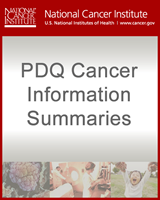From: Childhood Cancer Genomics (PDQ®)

NCBI Bookshelf. A service of the National Library of Medicine, National Institutes of Health.

Figure 10. A comprehensive profile of the genetic abnormalities in Ewing sarcoma and associated clinical information. Key clinical characteristics are indicated, including primary site, type of tissue, and metastatic status at diagnosis, follow-up, and last news. Below is the consistency of detection of gene fusions by RT-PCR and whole-genome sequencing (WGS). The numbers of structural variants (SV) and single-nucleotide variants (SNV) as well as indels are reported in grayscale. The presence of the main copy-number changes, chr 1q gain, chr 16 loss, chr 8 gain, chr 12 gain, and interstitial CDKN2A deletion is indicated. Listed last are the most significant mutations and their types. For gene mutations, “others” refers to: duplication of exon 22 leading to frameshift (STAG2), deletion of exon 2 to 11 (BCOR), and deletion of exons 1 to 6 (ZMYM3). Reprinted from Cancer Discovery, Copyright 2014, 4 (11), 1342–53, Tirode F, Surdez D, Ma X, et al., Genomic Landscape of Ewing Sarcoma Defines an Aggressive Subtype with Co-Association of STAG2 and TP53 mutations, with permission from AACR.
From: Childhood Cancer Genomics (PDQ®)

NCBI Bookshelf. A service of the National Library of Medicine, National Institutes of Health.